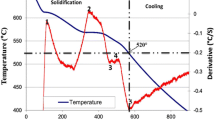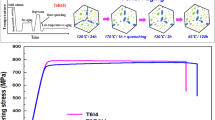Conclusions
A magnesium addition promotes densification of Al-Cu alloy specimens sintered for short periods of time in the range 595–635‡C. Longer sintering at 615 and 635‡C results in higher specimen porosity. At a temperature above 595‡C Al-Cu alloys experience severe coarsening. Alloying with magnesium does not significantly affect the structure of the alloys. A magnesium addition improves the mechanical properties of an Al-Cu alloy. The extent to which magnesium alters the mechanical characteristics of heat-treated Al-Cu alloys depends on sintering conditions. The highest strength — 340 MPa and δ=6% — is exhibited by specimens sintered for 45 min at 595‡C.
Similar content being viewed by others
Literature cited
A. P. Savitskii and L. S. Martsunova, “Effect of solid-state solubility on the volume changes experienced by aluminum during liquid-phase sintering,” Poroshk. Metall., No. 5, 14–19 (1977).
A. P. Savitskii, V. G. Gopienko, L. S. Martsunova, and Val. G. Gopienko, Technological Operations in the Production of P/M Aluminum Materials [in Russian], Tsentr. Nauchno-Issled. Inst. ékonom. Inform. Tsvetn. Metall., Moscow (1983).
A. P. Savitskii, A. I. Karakulov, and L. S. Martsunova, “The sintering of aluminum in the presence of a liquid phase,” Izv. Vyssh. Uchebn. Zaved., Fiz., No. 8, 12–17 (1968).
T. Watanabe and K. Yamada, “Effect of method of adding copper on the strength of sintered Al-Cu alloys,” Int. J. Powder Metall.,4, No. 3, 37–47 (1968).
L. S. Martsunova, A. P. Savitskii, é. N. Ushakova, and B. I. Matveev, “Sintering of aluminum with copper additions,” Poroshk. Metall., No. 12, 14–18 (1973).
W. Kehl and H. F. Fischmeister, “Liquid phase sintering of Al-Cu compacts,” Powder Metall.,23, No. 3, 113–119 (1980).
W. Kehl and H. F. Fischmeister, “Observations on dimensional changes during sintering of Al-Cu compacts,” Mater. Sci. Monographs,14, 269–275 (1982).
A. P. Savitskii, G. N. Romanov, and L. S. Martsunova, “Deformation of aluminum-copper powder solids during liquid-phase sintering,” Poroshk. Metall., No. 8, 39–43 (1985).
F. Farzin-Nia and B. L. Davies, “Production of Al-Cu and Al-Cu-Si alloys by PM methods,” Powder Metall.,25, No. 4, 209–215 (1982).
B. L. Davies and F. Farzin-Nia, “Precipitation hardening of P/M aluminum-copper alloys,” Int. J. Powder Metall. Powder Technol.,19, No. 3, 197–209 (1983).
S. Storchheim, F. Hills, and A. Cross, “Powder metallurgy,” U.S. Pat. No. 3336479, Sept. 10, 1968.
E. Ramasamy and P. Ramakrishnan, “Some studies on the aluminium alloy formation during sintering of metal powders,” in: Powder Metallurgy Alloys: Proceedings of the Symposium on Powder Metallurgy Alloys (Bombary, Oct. 11, 1980), Balkema, Rotterdam (1982), pp. 37–47.
M. Hansen and K. P. Anderko, Constitution of Binary Alloys, McGraw-Hill, New York (1957).
H. W. L. Phillips, Annotated Equilibrium Diagrams of Some Aluminium Alloy Systems, Monograph No. 25, Inst. Met., London (1959).
W. A. Kaysser, W. J. Huppmann, and G. Petrow, “Analysis of dimensional changes during sintering of iron-copper mixtures,” Powder Metall.,23, No. 2, 86–91 (1980).
D. Berner, H. E. Exner, and G. Petrow, “Swelling of iron-copper mixtures during sintering and infiltration,” Mod. Develop. Powder Metall.,6, 237–250 (1974).
G. Petrow and W. A. Kaysser, “Liquid phase sintering,” Sci. Ceram.,10, 269–278 (1980).
W. J. Huppmann, H. Riegger, W. A. Kaysser, et al., “The elementary mechanisms of liquid phase sintering,” Z. Metallk.,70, No. 11, 707–713 (1979).
T. K. Kang and D. N. Yoon, “Coarsening of tungsten grains in a liquid nickel-tungsten matrix,” Metall. Trans.,9A, No. 3, 433–438 (1978).
L. F. Mondolfo, Structure and Properties of Aluminum Alloys [Russian translation], Metallurgiya, Moscow (1979).
V. V. Hathi and C. M. Sliepcevich, “Effect of heat treatment temperature on the tensile strength and hardness of an isostatically compacted aluminium alloy blend,” Metall. Trans.,10A, No. 4, 509–510 (1979).
Author information
Authors and Affiliations
Additional information
Deceased.
Translated from Poroshkovaya Metallurgiya, No. 9(297), pp. 29–34, September, 1987.
Rights and permissions
About this article
Cite this article
Al'tman, A.B., Brodov, V.A., Zhil'tsov, A.V. et al. Effect of sintering conditions on the structure and mechanical properties of P/M aluminum base alloys. Powder Metall Met Ceram 26, 713–717 (1987). https://doi.org/10.1007/BF00797176
Received:
Issue Date:
DOI: https://doi.org/10.1007/BF00797176




